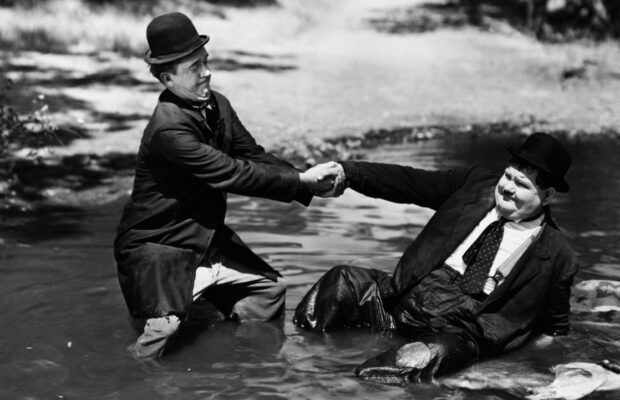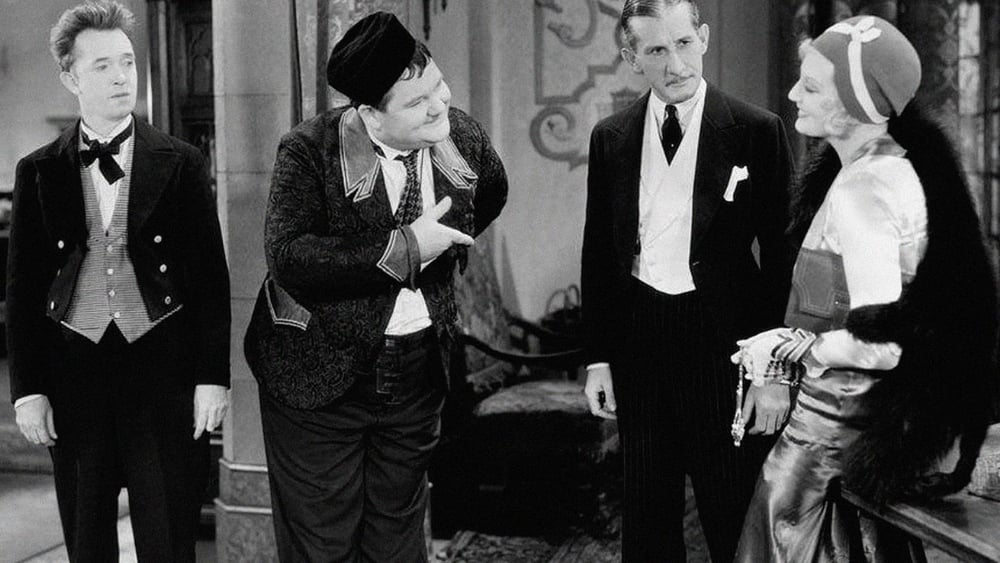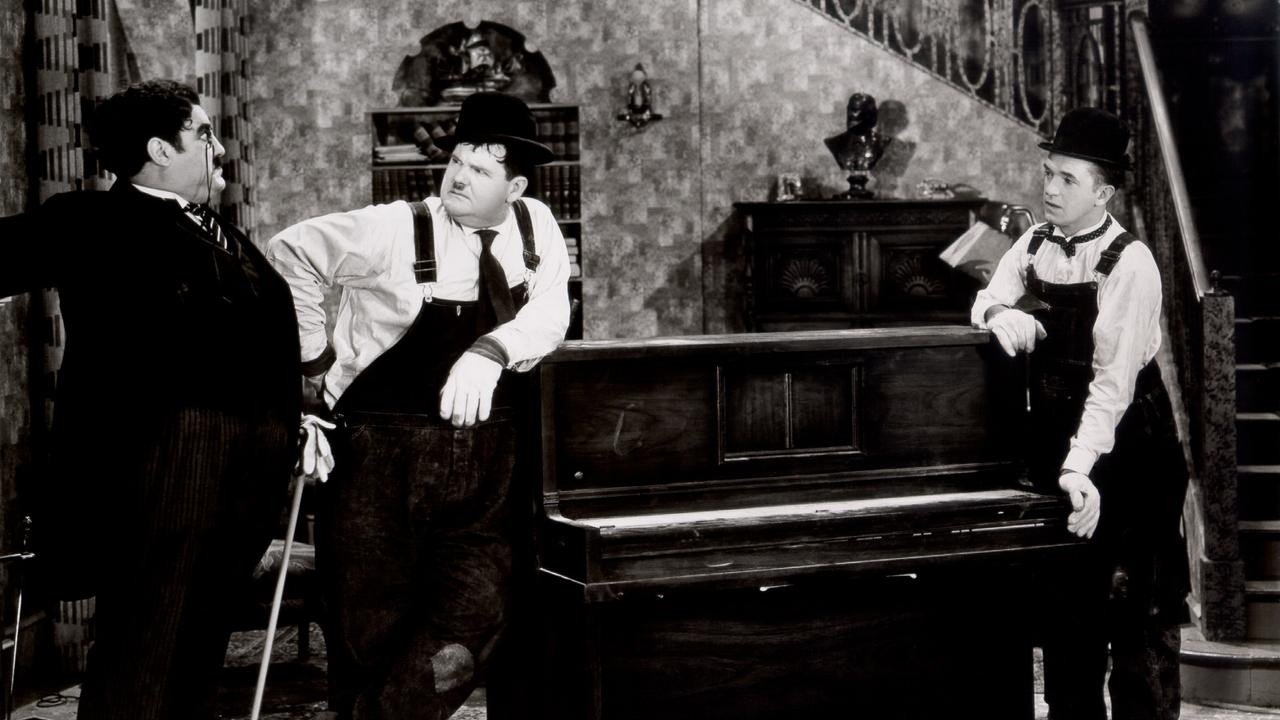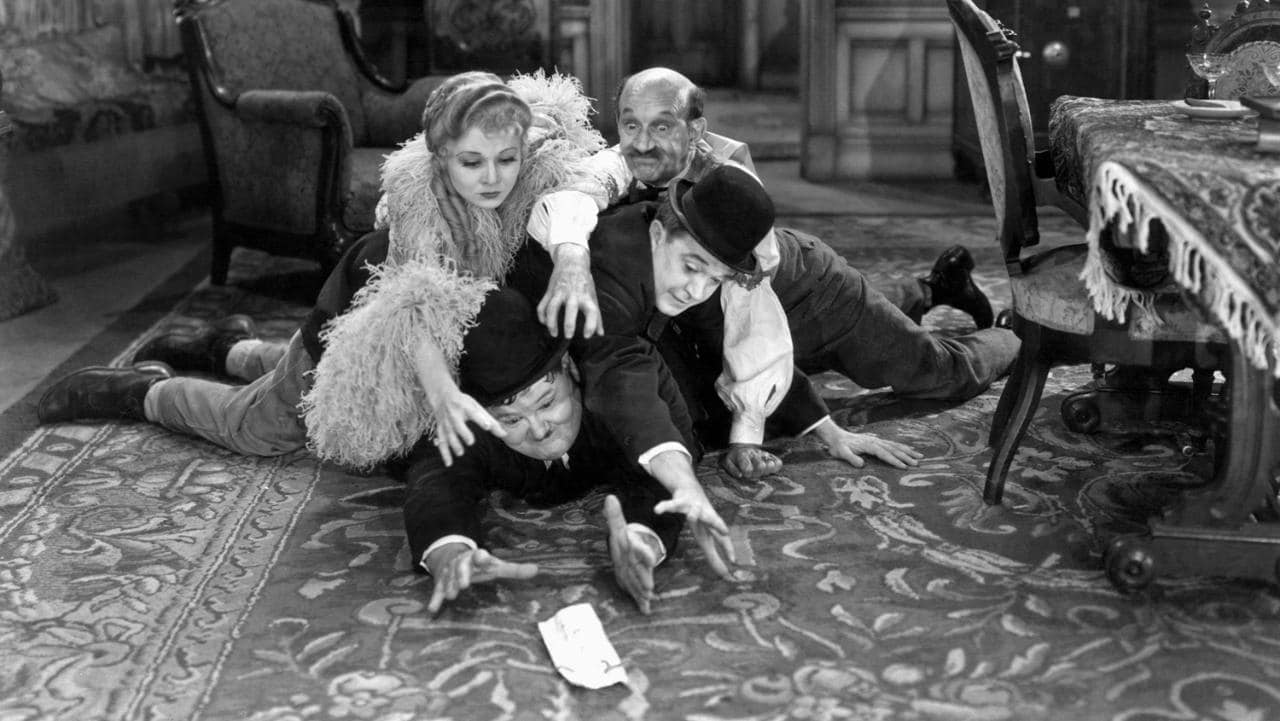Way Out West (1937)

Toronto Film Society presented Way Out West (1937) on Sunday, February 4, 2024 as part of the Season 76 Fall Series, Programme 3.
ANOTHER FINE MESS (1930)
Produced by Hal Roach; Directed by James Parrott; Camera: Jack Stevens. Released November 29, 1930.
Cast: Stan Laurel (Stan), Oliver Hardy (Ollie);, Harry Bernard (Policeman), James Finlayson (Colonel Buckshot), Thelma Todd (Lady Plumtree).

Colonel Buckshot (James Finlayson) is leaving for South Africa, and trusting the task of renting his mansion to his servants. Stan and Ollie, pursued by the law, take refuge in the house and overhear the servants plan to sneak away for the weekend.
Once they have, left the boys make several attempts to leave foiled each time by the ever present policeman outside. A complication develops with the arrival of prospective tenants, Lord and Lady Plumtree (Charles Gerrard and Thelma Todd).
Ollie tells Stan to borrow the butler’s uniform and informs the couple of the Colonel’s absence. Stan follows orders but cannot ask him to leave, having spotted the policeman. He calls for Colonel Buckshot, forcing Ollie to continue the charade. Greeting the couple with considerable grandeur, Ollie summons ‘Agnes’ the maid, taking Stan aside with instructions to don the maid’s outfit. Back with his visitors, the ‘Colonel’ is asked to play the piano (producing an elaborately topped entailed performance of Chopsticks) before Lord Plumtree asks to be escorted to the billiard room. Attempts to locate the room take them upstairs, where they meet ‘Agne’s, the bashful maid who trips downstairs straight into conversation with Lady Plumtree. After abandoning the search for the billiard room (with the discovery that Lord Plumtree does not even play), the astonished Ollie refines the details of renting the house at a low price, claiming ‘I picked it up for practically nothing myself’.
Negotiations for staff salaries necessitate a few quick changes of costume for Stan, who add one point combines the butler’s uniform with the maid’s wig. Back in his Agnes role, he answered the door to none other than the real Colonel, who has returned to fetch his bow and arrows. Ollie takes some time recognizing him, until Stan draws his attention to the Colonel’s portrait hanging nearby. They make a run for it; the Colonel calls the police and Lord Plumtree has to flee from the irate householder.
Stan and Ollie borrow an outsized goat skin, and escape under it on a tandem. The police chase this two-wheeled animal into a tunnel, where a streetcar tears off their uniforms. The bizarre cycling goat emerges as two separate creatures on unicycles.
This bizarre ending is matched by an eccentric beginning, with the opening credits spoken in unison by twin girls. In other respects, the humor in Another Fine Mess is conventional but very funny, bearing a proud heritage as a remake of the early Duck Soup, itself based on a stage sketch written by Laurel’s father. A facetious tone marks the soundtrack, which employs spot effects of slide-whistles and musical stings to punctuate the action more than in any other Laurel and Hardy talkie, effects usually quite alien to the team’s sophisticated slapstick. Research suggests that no foreign versions were made, Laurel’s personal list of his films noting any alternative editions an including none for this film; this applies also to Roach studio records. A reported version called De Bote en Bote was later confirmed as a Spanish title for Pardon Us.
THE MUSIC BOX (1932)
Produced by Hal Roach. Directed by James Parrott. Camera: Walter Lundin, Len Powers. Released April 16, 1932.
Cast: Stan Laurel (Stan Laurel), Oliver Hardy (Ollie Hardy), Billy Gilbert (Professor von Schwarzenhoffen), Hazel Howell (Mrs. von Schwarzenhoffen).

Stan Laurel’s personal favourite of the films, The Music Box was recognized in its day by an Oscar for ‘Best Live-Action Short Subject’. Some admirers find the repetition wearing (particularly at three reels) but this tends to be after several screenings. This said, most agree with the films’ high reputation, rivalled only by the silent Two Tars and Big Business, or the talkie short Helpmates. The Music Box is itself based on another silent, Hats Off.
As an example of subtle slapstick, The Music Box displays how violent gags can acquire intelligence; when Stan brings a ladder into shot, the far end disappears behind the piano, from which we hear a dull thud and a yell followed by the sight of Ollie standing up, nursing his eye. The boys’ unintelligent adherence to procedure is typified when they take the piano back to the street in order to bring it up by the correct route.
A subtle, cinematic gag (often taken as technical carelessness) occurs when Stan’s descent into the pond is punctuated by the obvious throwing of two buckets of water from different directions. Another such challenge to audience credulity appears in The Midnight Patrol. Despite this apparent unreality (crowned by the perversity of a strong-willed piano), The Music Box parallels human behaviour quite realistically: interviewed for the BBC documentary Cuckoo, Kenneth Tynan recalled having unconsciously duplicated Ollie’s painful trading on an exposed nail. On the same programme, Jerry Lewis considered the film’s very subject matter to be an extension of Stan’s spirit, the outlook of a man less interested in the aesthetic joys of music than in the tribulations of whoever had to deliver the instrument. This might be considered a little fanciful but there is no denying The Music Box in its place in legend.
WAY OUT WEST (1937)
Production Company: Stan Laurel Productions for Hal Roach. Director: James W. Horne. Camera: Art Lloyd, Walter Lundin. Released April 16, 1937.
Cast: Stan Laurel (Stan Laurel), Oliver Hardy (Oliver Hardy), Sharon Lynn (Lola Marcel), James Finlayson (Mickey Finn), Rosina Lawrence (Mary Roberts).

Life in the western town of Brushwood Gulch centres around the saloon run by Mickey Finn (James Finlayson) and his wife, singer Lola Marcel (Sharon Lynne). Slaving in the kitchen is Mary Roberts (Rosina Lawrence), who has been in their charge since childhood. When two prospectors, Stan and Ollie, arrive with a deed to a gold mine left by Mary’s late father, Finn, seeing an opportunity, passes Lola off as the heiress. By the time Stan and Ollie realize the deception, Mary has already been tricked into signing the deed over to the Finns. Attempts to retrieve it are not helped by the arrival of the town’s Sheriff (Stanley Fields), who had ordered them out of town earlier that day. That night they break into the saloon, recover the deed and leave with Mary, with plans to settle ‘way down south’.
Last of the team’s two ‘Stan Laurel Productions’, Way Out West is one of their most popular films, a TV perennial and frequent rival to Sons of the Desert when evaluating their best feature-length films. The reasons for this popularity are clear: most of their comedy’s best elements are present, as is familiar foil James Finlayson.
The plot, as in the earlier feature, involves them completely and is enough to sustain the length without padding. Finlayson’s melodramatic villainy finds a perfect setting, while Sharon Lynne, whose background was in musicals, is ideal as his unscrupulous wife. Another bonus is the presence of three musical numbers involving the team, including a dance (much prized by impersonators) to ‘At the Ball, That’s All’ and the song ‘The Trail of the Lonesome Pine’, which, when issued as a 45 pm record late in 1975, reached number two in the UK charts.
One of the highlights of the latter song is that Stan takes over the chorus, singing it first in a robust bass, thus annoying Ollie who, after asking the bartender for a large wooden mallet, proceeds to hit his pal firmly over the head. Stan’s voice immediately changes from bass to high soprano, and he promptly falls down out of camera range. The bass voice was dubbed by Chill Wills, the soprano by Rosina Lawrence, heroine of the film.
As William K. Everson noted, Way Out West differs from most comic westerns by actually parodying the genre rather than merely using a western setting. Mel Brooks’ more recent Blazing Saddles attempts the same but is over-reliant on self-conscious dialogue references and suffers from a tendency to stray from the target. The success of Way Out West may owe something to Stan Laurel’s early experience in parody (he was soon also to become a producer of westerns); similarly, Oliver Hardy’s earlier work in silent westerns would have contributed. One might add that a sequence in which saloon-singer Lola uses a mirror to reflect the spotlight at various men in the audience (much imitated since) occurs in The Show, a 1922 film in which Hardy supports Larry Semon.
The parody element extends far enough to include a moment where Stanley rolls up a trouser leg to halt a stagecoach; a precise imitation of Claudette Colbert’s hitchhiking methods in It Happened One Night (complete with close-up of braking wheel); it reflects the best Laurel parodies of the 1920s through being amusing in its own right. At least two accounts describe a sequence unique to British prints in which Laurel & Hardy are confused by a revolving signpost.
Although stills exist suggesting such a scene, all available copies seem to derive from American material, usually the reissue by Film Classics or, less commonly until the recent restorations, the original (distinguishable by the M-G-M logo on the main title card). The signpost sequence is detailed in the original shooting script, reprinted in the Winter 1991/2 edition of Blotto magazine from the collection of Ray Andrew.
An interesting fragment in the gag reel That’s That! juxtaposes shots of Stanley Fields with Tiny Sandford (both ) in the role of Sheriff (Sandford was replaced during production). Coincidentally, the two had appeared together in the previous year’s version of Show Boat.
Reprinted from the Laurel & Hardy Encyclopedia by Glenn Mitchell with permission










Leave a Reply